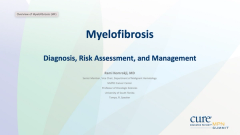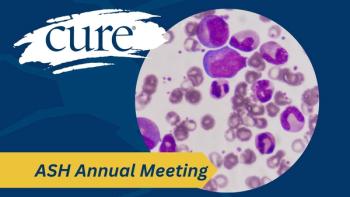
Educated Patient® MPN Summit Current Management of PV Presentation: May 20, 2023
Watch Dr. Nikolai Podoltsev, from Yale School of Medicine, discuss the current management of polycythemia vera during the CURE® Educated Patient® MPN Summit.
Episodes in this series

It is essential for patients with polycythemia vera — a type of myeloproliferative neoplasm (MPN) — to discuss disease symptoms with their clinical team, as they can lend insight into treatment for the disease, explained Dr. Nikolai Podoltsev.
“For polycythemia vera, we, of course, would like to reduce the incidence of thrombosis and hemorrhage — this is the primary goal for all of the treatments,” Podoltsev, who is an associate professor of hematology and associate program director of the Hematology and Medical Oncology Fellowship Program at Yale School of Medicine, said during his presentation at the CURE® Educated Patient® MPN Summit.
“But also, we would like to control symptoms, which can be accomplished with the treatments (for polycythemia vera.”
Common effects that patients with polycythemia vera may experience include headache/dizziness, blurred vision, erythromelalgia (burning and redness in the hands and feet), stroke, heart attack, venous thrombosis, fatigue, night sweats, weight loss, itching and spleen enlargement.
After receiving a diagnosis of polycythemia vera, patients will likely be put on a regimen of low-dose aspirin to manage cardiovascular risk that comes along with the disease.
Based on polycythemia vera symptoms and other patient characteristics, clinicians may put patients into the high- or low-risk category. Typically, Podoltsev explained, low-risk patients are those who are under the age of 60 and have no prior history of thrombosis (blood clots), whereas high-risk patients are older than 60 and may have previously experienced thrombosis.
Patients who are high risk will likely undergo cytoreductive therapy with Hydrea (hydroxyurea) or an interferon agent. The goal of this type of treatment is to control blood cell counts. Similarly, if low-risk patients experience one or more of the following, they may undergo cytoreductive surgery as well as:
- worsening symptom burden
- new thrombosis or bleeding events
- poor tolerance to having blood taken
- increase in white blood cells and/or platelets
Then, if patients’ disease stops responding to therapy or if they experience any of the above side effects while on cytoreductive therapy, clinicians may talk to their parents about the potential use of Jakafi (ruxolitinib) or an interferon agent, if not previously used, to manage the disease.
Podoltsev mentioned that what is feared most by patients with polycythemia vera is that their disease will transform into primary myelofibrosis and then acute myeloid leukemia (AML) — a much more aggressive form of blood cancer.
Podoltsev mentioned that this is a relatively rare occurrence, though, with approximately 10% of patients with polycythemia vera experiencing disease change to primary myelofibrosis, and then 20% of patients with primary myelofibrosis ending up with AML.
“The goal of treatment (for polycythemia vera) is to reduce the risk of thrombosis and hemorrhage and control symptoms,” Podolstev said. “Hopefully in the future, we’ll have drugs which are going to prevent and delay transformation to myelofibrosis and AML.”
For more news on cancer updates, research and education, don’t forget to












